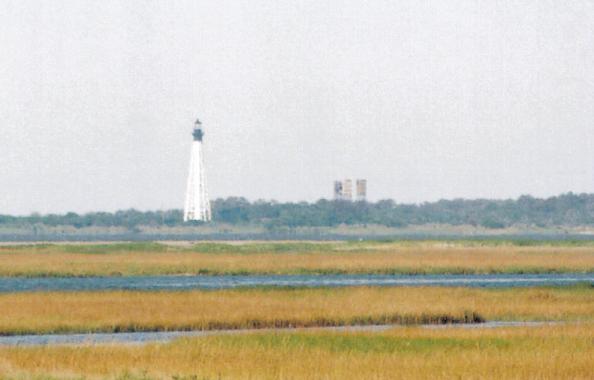As the development of the young nation continued, numerous ports were being established on the Chesapeake Bay. The Cape Henry light station was established in the late 1700’s at the southern entrance to the Chesapeake Bay, but it wasn’t until the late 1820’s that a light station would mark the northern entrance. Completed in 1828 at a cost of $7,400, the Cape Charles light station, located on Smith Island, was completed in an attempt to aid navigation around the cape and into the bay. However, it was long until mariners were complaining about the ineffectiveness of the light. The light could only be seen for about twelve miles
To visit the Cape Charles Lighthouse, a boat is needed to travel out to Smith Island. Views (however quite distant) of the light are available from Fisherman’s Island, which is accessed by the Chesapeake Bay Bridge Tunnel, which crosses the mouth of the Chesapeake Bay. No stopping is allowed on the bridge at this location so you either take photos while in the moving vehicle, or stop and risk getting a citation. The lighthouse is four miles away from this point. The lighthouse can also be seen from the parking area on the northbound side of the bridge, immediately after you exit the bridge. However, this view is still three and a half miles away.
under the best conditions, and if there should be fog or other foul weather, the light was basically useless.
Although inadequate, the light remained in service until 1858 when the Lighthouse Board began construction on a new 150-foot tower, located almost a mile from the original station. Construction of the brick tower was slowed by material shortages and weather. By the time the Civil War began, only about half of the tower was completed. As with many southern lighthouse sites, Confederate raiders attacked the site and destroyed everything they could. When the war ended, two years of construction were needed to repair the damage and finish the station. Fitted with a first order Fresnel lens, the lamps were first lit on May 17, 1864.
Even though it took six years to get the tower operational, by 1883, the tower was in danger of being lost due to erosion. Erosion along the shoreline was so bad that it was measured at a rate of thirty feet a year. Although attempts were made to stop the eroding shoreline, these efforts were ineffective. The decision was made to build another light station, instead of trying to continue to save the existing structure.
In 1892, construction began on the third tower to mark the cape. Construction took two years and the 191-foot steel skeleton tower was completed and put in to operation. The lighthouse was automated in 1963 and its Fresnel lens removed and put on display at the Newport News Maritime Museum. Today the lighthouse continues to mark the cape and the northern entrance to the bay. Plans are being made by the Coast Guard to declare the station surplus property sometime in the future under the National Historic Lighthouse Preservation Act of 2000, making ownership of the lighthouse available to a qualified entity who must maintain and preserve the station and open it to the public.


